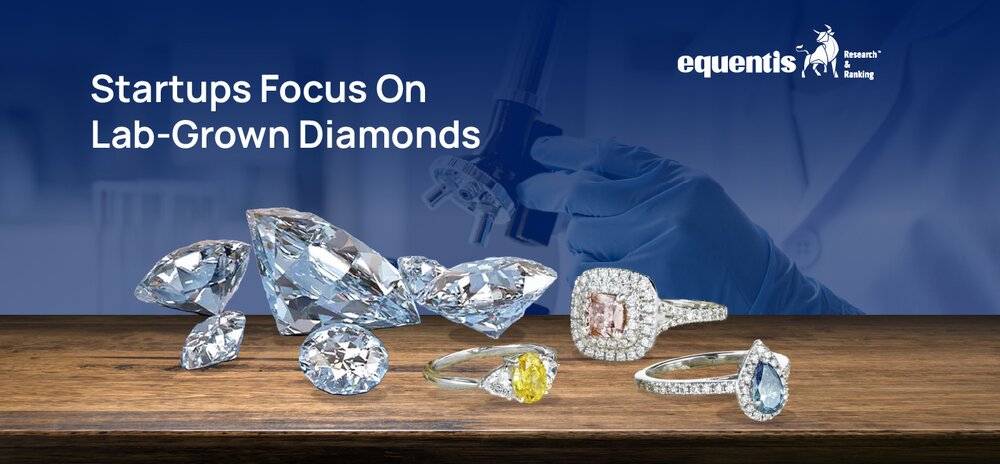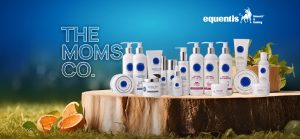Diamonds have long been a symbol of luxury, love, and status. However, the industry is undergoing a massive transformation as lab-grown diamonds (LGDs) gain popularity among young and conscious buyers.
With their affordability, ethical sourcing, and sustainability, these stones are changing the traditional diamond market. Several Indian startups are ramping up investments in marketing, product expansion, and consumer education to drive awareness and boost sales.
India’s Growing Dominance in the Lab-Grown Diamond Industry
India has emerged as a leading producer of lab-grown diamonds, contributing approximately 15% of global production. With an estimated 3 million lab-grown diamonds produced annually, the country’s industry is primarily driven by major hubs like Surat and Mumbai.
In 2022, the Indian lab-grown diamond jewelry market was valued at around $264.5 million. The market is poised for substantial growth, with sales expected to rise at a CAGR of 14.8% over the next decade. By 2033, the total market size is projected to expand from $299.9 million in 2023 to $1.19 billion.
Source: Indextb.com
How Lab-Grown Diamonds Are Made
Before diving into changing consumer preferences, let’s understand how they are made. Lab-grown diamonds are created using two methods: High Pressure High Temperature (HPHT) and Chemical Vapor Deposition (CVD). In HPHT, carbon is exposed to extreme heat and pressure, mimicking natural diamond formation. In CVD, a gas mixture is heated in a chamber, allowing carbon atoms to layer and form a diamond. Both methods produce real, high-quality diamonds.
A Sparkling Shift in Consumer Preferences
Some consumers are still skeptical about lab-grown diamonds, but more buyers are choosing them because they are just like mined diamonds in appearance and composition. Brands like Jewelbox and Svaraa are driving this shift, making LGDs more popular. Let’s see how these companies are leading the change and how the industry is evolving.
The Marketing Push and Spreading Awareness
A major challenge for LGD companies is changing the mindset around synthetic diamonds. Many consumers still see mined diamonds as better, not realizing that lab-grown ones look the same. To address this, startups are investing in marketing and awareness campaigns.
- Kolkata-based Jewelbox has nearly doubled its marketing budget over the past year, with 20% of its digital spends focused on educating consumers. Their campaigns aim to address misconceptions and highlight the benefits of LGDs. They also actively share informative videos on platforms like Instagram and YouTube, explaining the science behind lab-grown diamonds and guiding customers in choosing the right one.
Source: Mint
- The brand recently gained widespread attention after appearing on Shark Tank India Season 3, securing commitments from notable investors like Peyush Bansal (Lenskart), Aman Gupta (boAt), Vineeta Singh (Sugar Cosmetics), Radhika Gupta (Edelweiss Mutual Fund), and Ritesh Agarwal (Oyo). This has further boosted awareness and credibility for lab-grown diamonds in India.
- Similarly, Svaraa, a Surat-based startup, has invested ₹10 crore in marketing since its inception in 2021. The company, backed by Kalamandir Jewellers, plans to allocate another ₹20-30 crore in the next two years to strengthen its brand positioning and consumer outreach. The company believes that targeted campaigns have played a crucial role in increasing acceptance, especially in the wedding and daily-wear jewellery segments.
Source: Mint
Growing Acceptance: A New Era for Diamonds
Lab-grown diamonds are witnessing significant traction among young buyers, particularly first-time diamond purchasers and budget-conscious consumers. Brands are already seeing encouraging numbers, indicating a shift in consumer behavior.
- Jewelbox projects that its FY26 revenue will more than double to ₹35 crore, driven by demand from millennials and Gen Z buyers. Svaraa, on the other hand, has experienced a 60% increase in inquiries and a 45% rise in sales over the past few months. The affordability factor plays a key role, as lab-grown diamonds cost 30-50% less than their mined counterparts.
Source: Mint
- According to industry experts, these diamonds possess the same physical and chemical properties as natural diamonds, making them a compelling alternative. They believe LGDs have the potential to outperform mined diamonds in clarity and color. Gobal trends suggest rising consumer acceptance, particularly in wedding rings and high-end jewellery.
- A recent Kotak Institutional Equities report supports this claim, indicating that Indian women are likely to incorporate both natural and lab-grown diamonds into their collections. The study attributes this trend to higher education levels, rising disposable incomes, and evolving fashion preferences. Meanwhile, Morgan Stanley projects that the global diamond certification market will grow from $600 million to $1 billion by 2028, driven by a 25% increase in lab-grown diamond certifications.
Source: Mint
Overcoming the “Not Real Diamond” Perception
Despite their growing popularity, lab-grown diamonds still face a perception challenge. Many people associate diamonds with investment value, even though historically, they have been among the least-performing asset classes.
To counter these misconceptions, LGD brands are focusing on customer segmentation and targeted messaging. For instance, Jewelbox classifies its customers into two groups:
- First-time buyers looking for affordable diamond alternatives.
- Experienced diamond buyers seeking innovation and sustainability.
By catering to both segments without alienating either, the brand ensures a balanced market approach. It believes that aspirational value remains key, and brands must align their messaging to maintain diamonds’ desirability.
Source: Mint
The Branding Dilemma: Luxury vs. Fashion
To establish themselves in the jewellery market, LGD brands must define their positioning clearly. Industry experts highlight an important question—should lab-grown diamonds be marketed as luxury jewellery or high-end fashion accessories?
For LGDs to thrive, companies must communicate whether their product is a premium embellishment or a traditional jewellery piece with lasting value. Unlike mined diamonds, which carry an emotional and legacy factor, lab-grown diamonds need strong storytelling and brand-building strategies to create a similar connection.
Industry experts believe that the LGD industry is capital-intensive. To scale, brands need to invest in physical retail expansion, digital presence, and aggressive marketing. They highlight the importance of developing an omnichannel approach, ensuring that customers can experience LGDs both online and in-store.
Traditional Jewellers Take Notice
The rapid adoption of lab-grown diamonds has even caught the attention of traditional jewellers. Trent, the retail arm of Tata Group, launched its LGD brand ‘Pome’ last year, marking its entry into the sustainable luxury segment. While many legacy jewellers remain cautious, some are gradually testing the waters.
Source: Mint
A Sustainable Luxury Revolution
Lab-grown diamonds are on the rise as awareness campaigns highlight their ethical, sustainable, and cost benefits, attracting more buyers.
Brands like Jewelbox and Svaraa are seeing success with increasing sales, loyal customers, and stronger recognition. The industry is at a turning point, and companies that invest in branding, clear messaging, and consumer education will lead.
With growing acceptance, the question is no longer about their authenticity but their role in the market. Will they redefine luxury jewelry or stay a niche option? One thing is certain—lab-grown diamonds are shaping the future of the industry.
Related Posts
Disclaimer Note: The securities quoted, if any, are for illustration only and are not recommendatory. This article is for education purposes only and shall not be considered as a recommendation or investment advice by Equentis – Research & Ranking. We will not be liable for any losses that may occur. Investments in the securities market are subject to market risks. Read all the related documents carefully before investing. Registration granted by SEBI, membership of BASL & the certification from NISM in no way guarantee performance of the intermediary or provide any assurance of returns to investors.
FAQ
What’s driving the growth of India’s lab-grown diamond market?
Strong marketing, affordability, and ethical sourcing are key factors. Rising consumer awareness and export demand fuel the industry’s rapid expansion.
How does the price of lab-grown diamonds compare to natural diamonds?
Lab-grown diamonds are significantly more affordable, typically 30-40% cheaper, making them a popular choice for budget-conscious consumers seeking similar brilliance.
Is the quality of lab-grown diamonds comparable to natural diamonds?
Yes, lab-grown diamonds possess identical physical, chemical, and optical properties to natural diamonds, offering the same sparkle and durability.
What are the environmental benefits of lab-grown diamonds?
Lab-grown diamonds are considered more sustainable, avoiding the environmental impact of traditional mining and often using renewable energy sources.
What is the projected market size of India’s lab-grown diamond industry by 2033?
The market is projected to reach $1.19 billion by 2033, driven by increasing consumer demand and strong export potential, showing strong growth.
How useful was this post?
Click on a star to rate it!
Average rating 0 / 5. Vote count: 0
No votes so far! Be the first to rate this post.
waitfor delay '0:0:5'--
I’m Archana R. Chettiar, an experienced content creator with
an affinity for writing on personal finance and other financial content. I
love to write on equity investing, retirement, managing money, and more.
 Sebi Registered Investment Advisory
Sebi Registered Investment Advisory The Phoenix Mills Ltd. (PDF)
The Phoenix Mills Ltd. (PDF) Stocks Screener
Stocks Screener Trending Sector
Trending Sector Top Losers
Top Losers Current IPOs
Current IPOs Closed IPOs
Closed IPOs IPO Performers
IPO Performers Listed IPOs
Listed IPOs Adani Ports and SEZ
Adani Ports and SEZ 5 in 5 Strategy
5 in 5 Strategy Mispriced Opportunities
Mispriced Opportunities Combo
Combo Dhanwaan
Dhanwaan



















